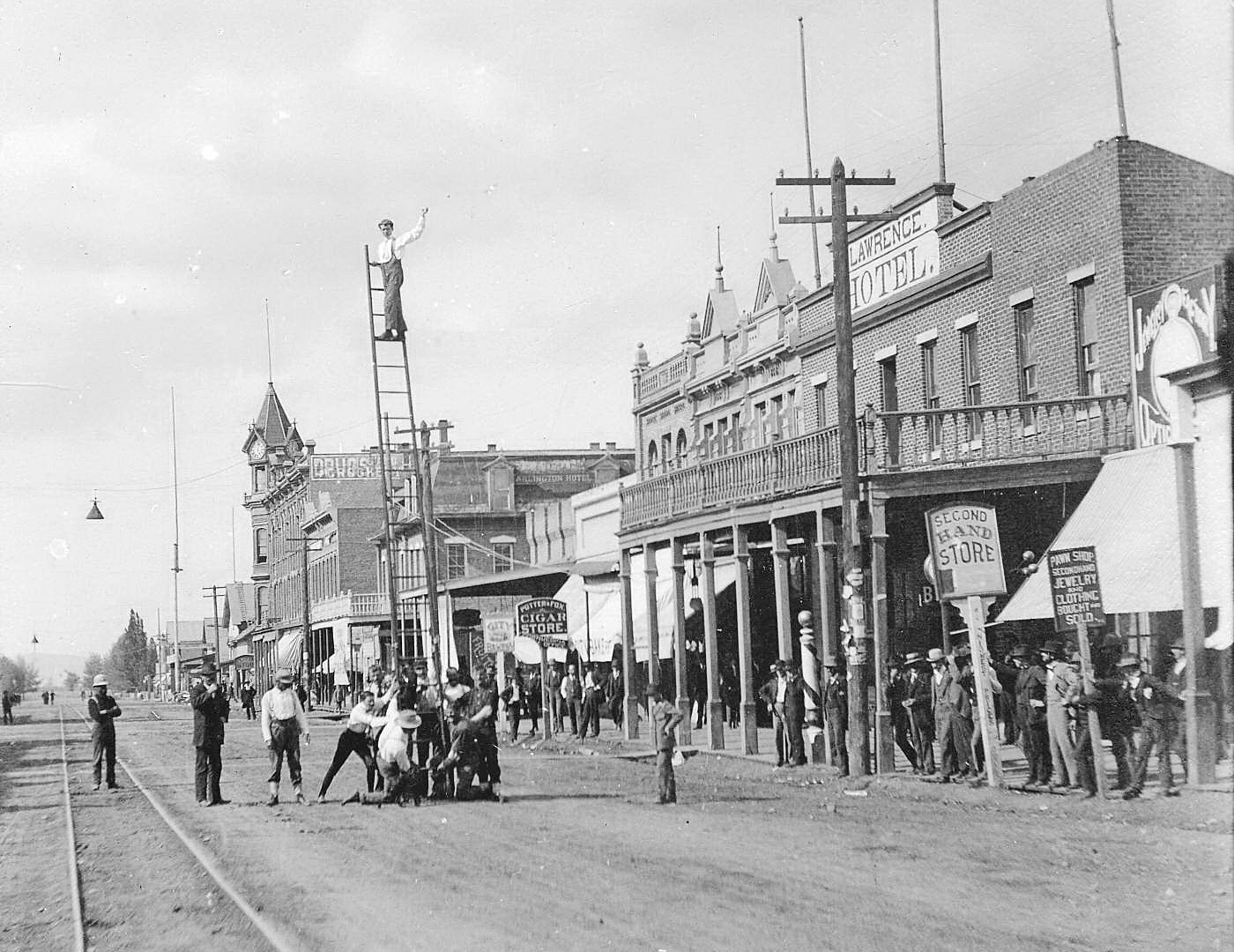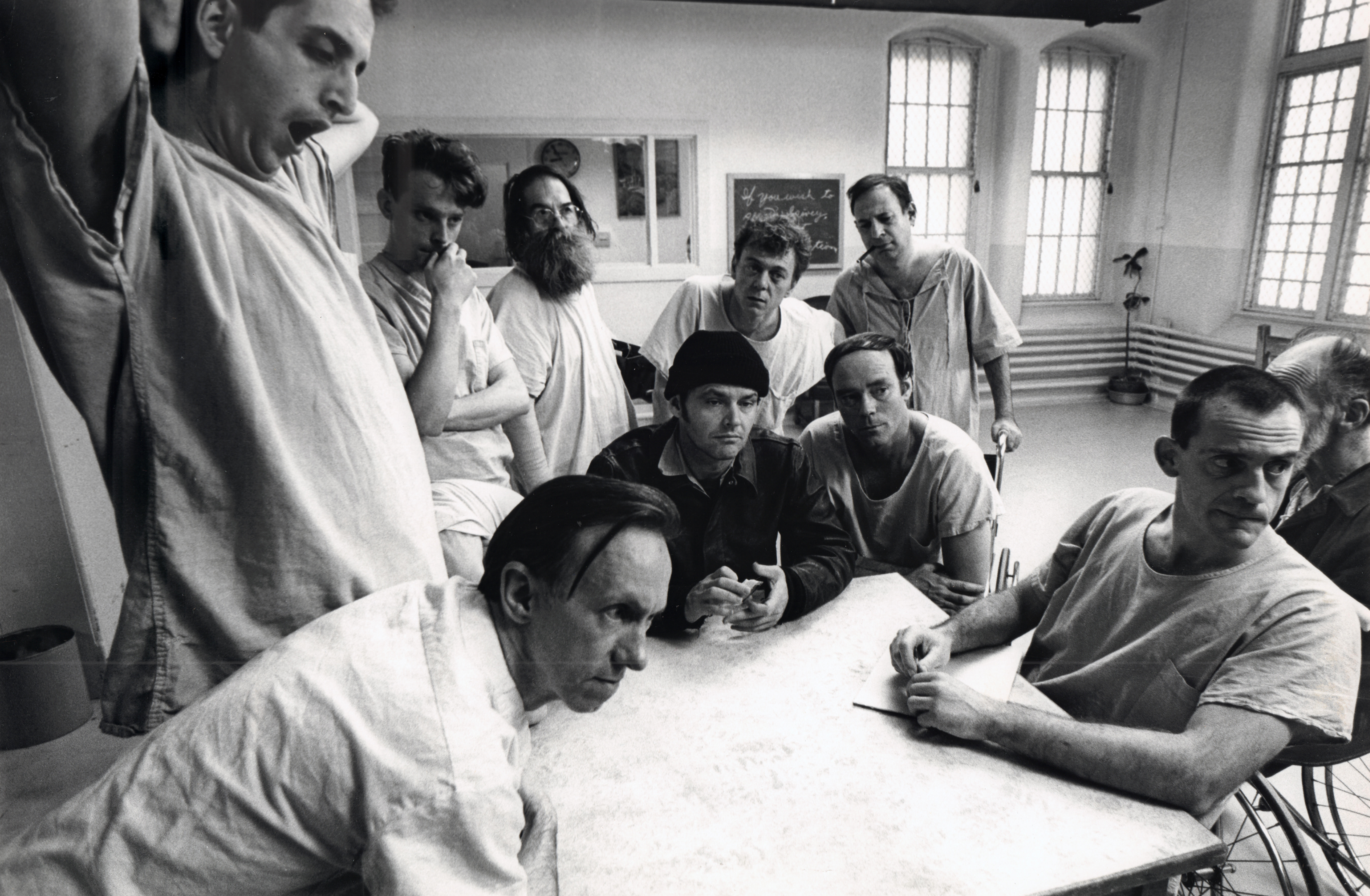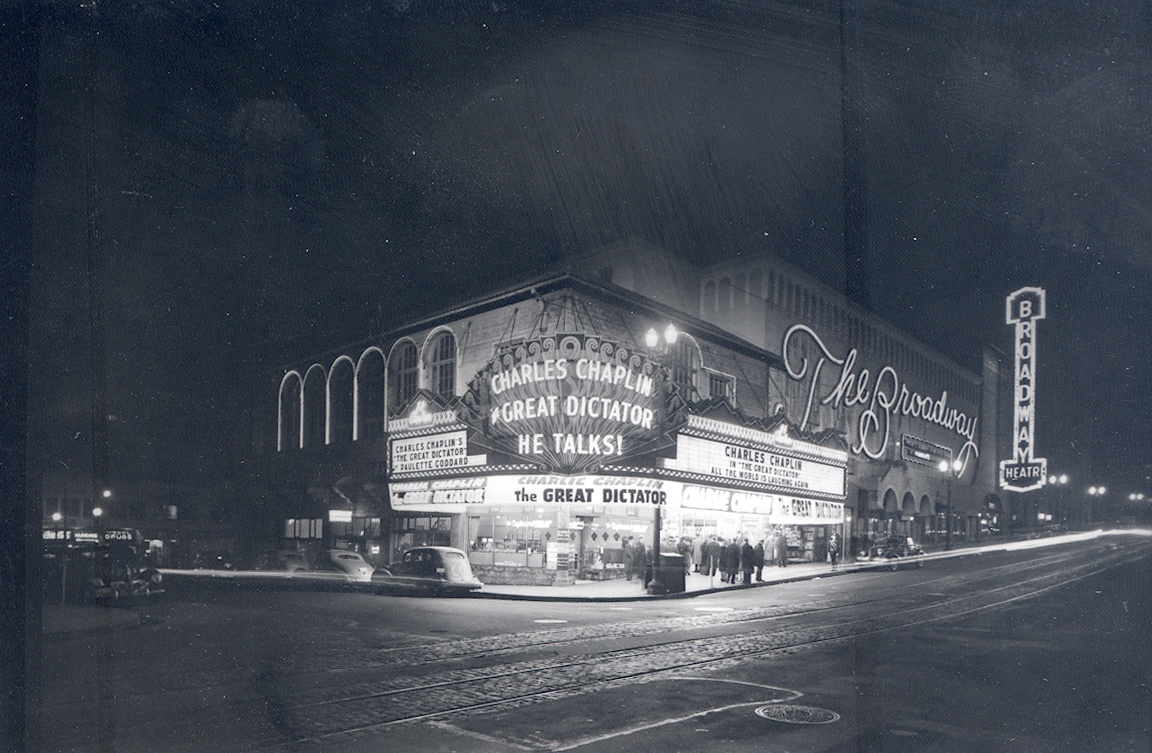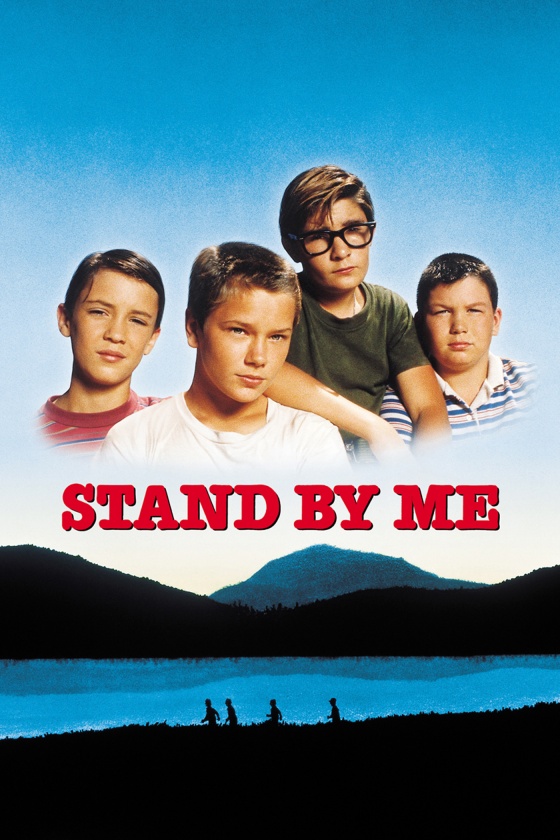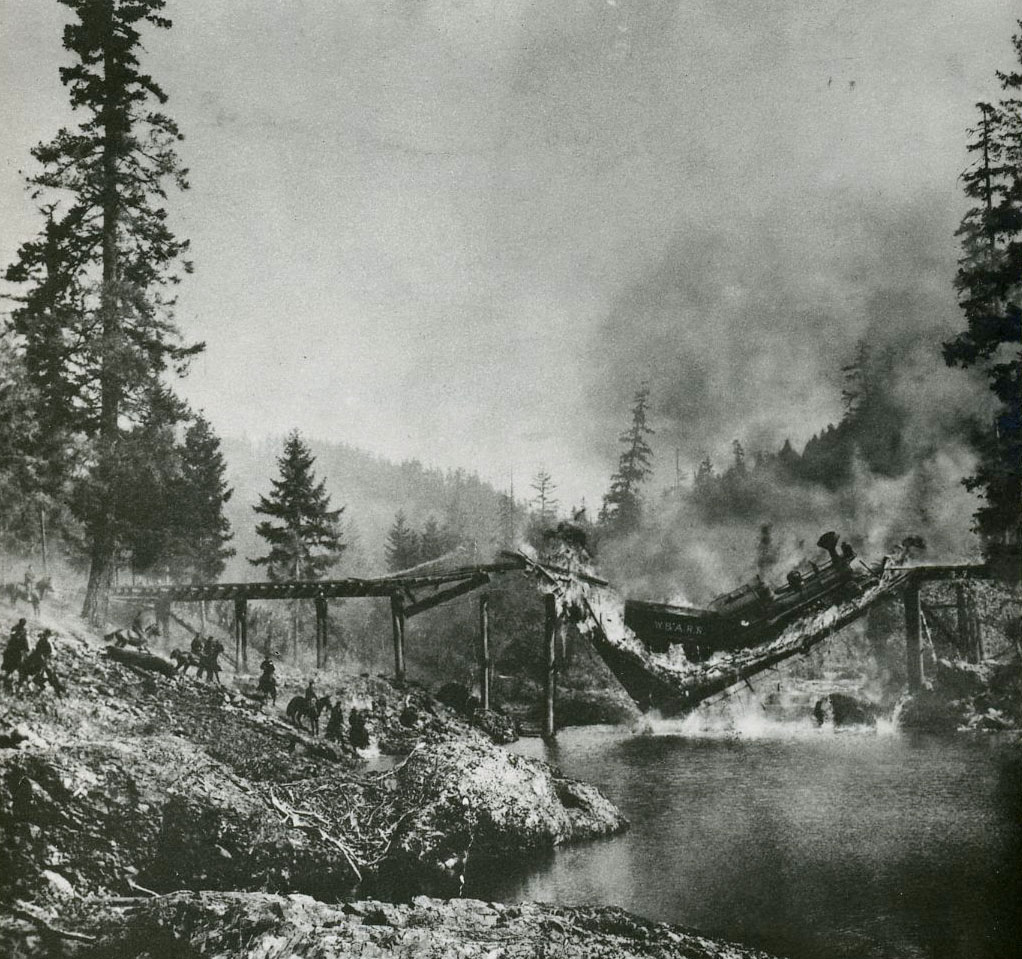A movie often considered to be one of the greatest Hollywood flops of all time was filmed in a remote valley in the Wallowa–Whitman National Forest in northeastern Oregon in 1968. The musical, Paint Your Wagon, tells the story of the rise and fall of No Name City, a mythical boomtown during the California Gold Rush. Ben Rumson, played by Lee Marvin, and his mining partner, known as Pardner, played by Clint Eastwood, find gold in a place that attracts hundreds of rowdy goldseekers. Before long, the tent city becomes a town, with all the vices associated with the Gold Rush. In the end, the gold runs out and the town collapses into tunnels that opportunists dug to recover gold dust that had fallen beneath the floorboards of the local saloons and dance halls.
Paint Your Wagon began as a modestly successful 1951 Broadway musical by Alan Jay Lerner and Frederick Loewe, whose hits included Brigadoon (1947) and My Fair Lady (1956). By the mid-1960s, Paramount Pictures, then part of the Gulf & Western conglomerate, owned the film rights to the play. Charles Bluhdorn, CEO of Gulf and Western, was determined to make a big-budget film to match the success of Mary Poppins (1964) and My Fair Lady (1964). He signed Marvin to star in the film for a million dollars and a percentage of the profits; Eastwood signed a similar deal.
Lerner, the author and lyricist of the original play, produced the film, and Joshua Logan, who had worked on South Pacific (1958) and Camelot (1967), was the director. Screenwriter Paddy Chayefsky wrote an adaptation of the original play, which dispensed with most of the original plot and characters in favor of a story designed to appeal to a younger, late-1960s, counterculture audience. His story featured Elizabeth, played by Jean Seberg, who ends up married to both Marvin’s and Eastwood’s characters in the film.
It was John Truscott, the production designer, who convinced Lerner that the film needed a “breathtaking location.” They found it during a plane ride over the Eagle Creek valley, 42 miles northeast of Baker (present-day Baker City). Logan objected to the location because of the difficulty of transporting the cast and crew for two hours over an unpaved forest road, but that problem was addressed at great expense by using helicopters. The producers were encouraged to film in Oregon by Governor Tom McCall, who created the Oregon Governor's Office of Film and Television in 1968 to organize logistical support for the Paint Your Wagon crew. Now known as Oregon Film, the state agency still recruits and supports the film industry.
It cost $2.4 million and seven months to construct No Name City on Eagle Creek, a set that included tunnels under the ersatz town and hydraulic lifts under the buildings to allow for their collapse in the final scene. McCall cut the ribbon at the town's opening. The production proved to be an economic boon for Baker, with Paramount bringing 400 cast and crew to town. They reportedly occupied all available lodging, and Paramount spent $6,000 a week on catering.
Filming began on June 24, 1968. Lerner was always on the set, frequently trying to overrule Logan’s directorial decisions, and Marvin was often drunk and abusive. Eastwood and Seberg engaged in an affair that ended when Seberg’s husband, French writer Romain Gary, arrived on the set and challenged Eastwood to a duel. In addition, Logan had to manage hundreds of extras, recruited from the area, to play miners. They camped on the set and were paid $20 a day; their pay was increased to $25 a day when they threatened to strike. Oregon Senator Wayne Morse made a cameo appearanve on horseback. Logan later wrote: “I got up at 4:30, took the helicopter an hour later, filmed all day, and flew back at night to eat and sleep. All I prayed for was that it would eventually end.”
Unusual summer weather added to production problems. Hundred-degree days were followed by the first August rainfall in the area in thirty-five years, a torrential downpour that delayed production by twenty-five days. Eventually, October snow forced the production to return to the Paramount lot in Hollywood. Filming ended the first week of December.
Post-production was equally fraught. Logan’s contractual rights to make the director’s cut was taken from him by Lerner, who made the final cut. A 166-minute version of the film was screened for the Motion Picture Association of America, which assigned it the first “M” (mature) rating given by its new Classification and Ratings Administration. The film was cut by thirty minutes for general release, and it premiered in New York on October 15, 1969. It then premiered in Portland on October 29 as a benefit for the Portland YWCA with Governor Tom McCall in attendance.
Reviews were mixed, but some were scathing. Rex Reed called it “a monument to unparalleled incompetence,” and Roger Ebert judged that “it doesn’t even inspire a put-down. It just lies there in my mind—a big, heavy lump.” The film was also a flop financially. Paramount claimed that it grossed nearly $14 million (about $126 million in 2024 dollars), but the production cost is estimated to have been at least $20 million (about $180 million in 2024). In a 1980s interview, Clint Eastwood summed up Paint Your Wagon: “It was a disaster, but it didn’t have to be such an expensive disaster….$20 million down the drain and most of it doesn’t even show on the screen.”
The U. S. Forest Service marks the remote location of No Name City on Eagle Creek with an interpretive site, and in 2018 Baker City and other communities celebrated the film’s fiftieth anniversary.
-
![]()
Paint Your Wagon poster.
Paramount Pictures
-
![]()
"Oregon Proves Perfect Spot for Filming," October 19, 1968.
San Francisco Valley Times
-
![]()
"'Paint Your Wagon' Stars Make Most of Oregon Locale," August 1968.
Portland Oregon Journal, August 26, 1968
-
![]()
"Horseman Wayne Morse Shouts His Lines In New Film, 'Paint Your Wagon,'" August 1968.
Portland Oregon Journal, August 8, 1968
-
![Governor Tom McCall attended a ribbon-cutting ceremony on the set of the town for the film Paint Your Wagon, filming in Baker City.]()
"Oregon governor opens movie's "No Name City,'" Calgary Herald, Sept. 30, 1968.
Governor Tom McCall attended a ribbon-cutting ceremony on the set of the town for the film Paint Your Wagon, filming in Baker City. Calgary Herald
-
![]()
Wayne Morse in costume as an extra in Paint Your Wagon, 1968.
Oregon Historical Society Research Library, Journal Coll. 013764
Related Entries
-
![Baker City]()
Baker City
The skyline of Baker City, at an elevation of 3,440, is dominated by tw…
-
![One Flew Over The Cuckoo's Nest (film)]()
One Flew Over The Cuckoo's Nest (film)
One Flew Over the Cuckoo’s Nest, a film based on the 1962 book by Orego…
-
![Oregon and the Film Industry]()
Oregon and the Film Industry
Early Filmmaking in Oregon Motion pictures debuted in Oregon in 1894 w…
-
![Stand By Me (film)]()
Stand By Me (film)
Stand By Me, a classic of 1980s American cinema, was filmed mostly in a…
-
![The General (film)]()
The General (film)
Buster Keaton's masterpiece and one of the greatest silent movies of al…
-
![The Way West (film)]()
The Way West (film)
The Way West, a big-budget western film that was universally panned by …
Related Historical Records
Map This on the Oregon History WayFinder
The Oregon History Wayfinder is an interactive map that identifies significant places, people, and events in Oregon history.
Further Reading
Medved, Harry, and Michael Medved. The Hollywood Hall of Shame: The Most Expensive Flops in Movie History. New York, NY: Putnam, 1984.
Parish, James Robert. Fiasco: A History of Hollywood’s Iconic Flops. New York, NY: Wiley, 2007.
Logan, Joshua. Movie Stars, Real People, and Me. New York, NY: Dell Pub. Co., 1979.
“Region Gets First Look at ‘Paint Your Wagon.’” Lebanon Express, October 22, 1969, p. 16.







